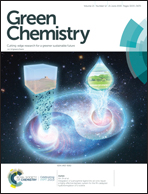System-level analysis and life cycle assessment of CO2 and fossil-based formic acid strategies†
Abstract
Formic acid (FA, HCOOH) using carbon dioxide (CO2) as a feedstock is sufficient to be synthesized on an industrial scale because it can be used as a carrier of hydrogen (H2) and as a precursor chemical in many chemical processes. Utilizing CO2 as an alternative carbon feedstock for FA production comes from reduction methods for greenhouse gas emission and fossil resource depletion. This study compares life cycle assessments (LCAs) to produce FA using CO obtained from fossil fuels (the conventional method), and using CO2 obtained using the carbon capture and utilization (CCU) method. The simulation compares supply energy (heat, electricity), and feedstock usage (CO, CO2, H2), and environmental impacts of FA production by the two processes in the Jeollanam-do industrial sector of Korea. The largest contributors to climate change (CC) were CO (71%) and heat (24%) in the fossil-based conventional process and H2 (76%) and electricity (9%) in the CCU process. The largest contributors to fossil resource depletion (FD) were CO (79%) and heat (18%) in the fossil-based conventional process and H2 (70%) and electricity (18%) in the CCU process. A case study showed that the lowest environmental impact was obtained using a combination of heat generation by burning wood chip, and electricity generation using hydropower. These results suggest that the use of captured CO2 for FA production can mitigate greenhouse gas emissions and fossil resource depletion.



 Please wait while we load your content...
Please wait while we load your content...